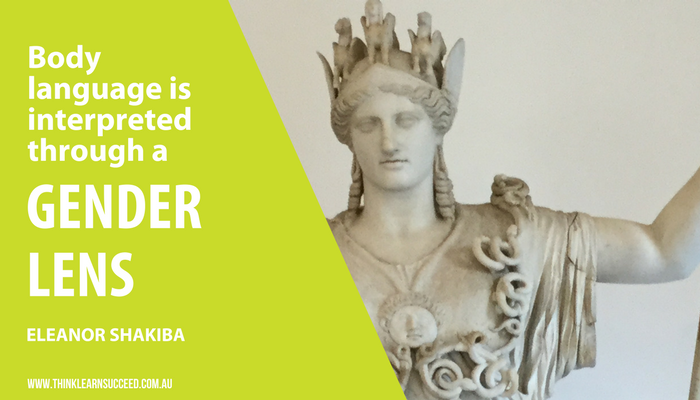 I love people-watching. As a trainer, of course, I have ample opportunity to do so. While groups are completing roleplays or activities, it’s my job is to observe their body language patterns and communication habits. Many years of closer observation have brought my attention to a problem which creates ‘glass ceiling moments’ for female negotiators. Here’s what I’ve noticed, when women step into senior roles, body language patterns that previously helped them in negotiation begin to backfire. For example, patterns of smiling frequently often can help a woman be successful in a junior role. When she’s attempting to negotiate as a leader, however, smiling too often will reduce her credibility and be perceived as an anxious habit.
I love people-watching. As a trainer, of course, I have ample opportunity to do so. While groups are completing roleplays or activities, it’s my job is to observe their body language patterns and communication habits. Many years of closer observation have brought my attention to a problem which creates ‘glass ceiling moments’ for female negotiators. Here’s what I’ve noticed, when women step into senior roles, body language patterns that previously helped them in negotiation begin to backfire. For example, patterns of smiling frequently often can help a woman be successful in a junior role. When she’s attempting to negotiate as a leader, however, smiling too often will reduce her credibility and be perceived as an anxious habit.
My background in social anthropology has taught me that all communication habits are interpreted through a social lens. Cultural meanings are unconsciously assigned to body language patterns and therefore language patterns. It struck me that Neuro Linguistic Programming, or NLP, would be a useful tool for exploring the double bind. After all, NLP modelling is a process for analysing the thinking patterns, language patterns and behavioural (or body language) patterns involved in human communication.
Thinking about NLP’s focus on excellence inspired me to tackle the double bind issue from a new angle. Initially, I had focused on solving the problem of why women underperform in negotiation contexts. Applying an excellence-based mindset, however, meant I could shift my efforts to exploring what highly successful female negotiators do differently to the rest of us. I discovered that superb female negotiators are skilled in managing conversational dynamics. They display six behavioural patterns, which fall into 3 categories;
[convertkit form=5135167]
Here’s a quick summary of my key observations. Firstly, savvy female negotiators have savvy mindsets. There are three main elements associated with the way they think. Most importantly, savvy female negotiators are fearless. By this, I don’t mean that they experience no anxiety. However, savvy female negotiators are substantially less anxious than most of us. I discovered this is because they use a structured process to guide their conversations. They don’t leave things to chance, instead they drive the negotiation through four key steps.
Mastering these steps, of course, allows any woman to become a more confident negotiator. The mindset of a savvy female negotiator is also outcome-focused rather than relationship-focused. This is an interesting distinction, because many females are socialised to make relationships their primary focus. In high-stakes negotiations, being fully focused on the relationship can mean that a woman takes things personally, when she needs to place her attention on how to solve problems and overcome barriers to collaboration. Savvy female negotiators achieve this by focusing on issues rather than focusing on interpersonal dynamics and what they might ‘mean’.
Secondly, highly skilled female negotiators use different language patterns to less effective women. They use active language patterns rather than passive language patterns. For example, they take the lead in framing a conversation as a negotiation by making statements, such as, ‘I’m willing to negotiate on that,’ or “Let’s negotiate”. Women who excel in the skill of negotiating also use a lot of solution focused questions and accord statements. Anyone who’s read my book, Difficult People Made Easy, or attended one of my conflict resolution workshops, will be familiar with accord statements. These create bridges to finding solutions by emphasising what you agree with in your counterparts stance. Savvy female negotiators use these language patterns far more often than most of us.
Finally, successful female negotiators focus on exchanging rather than giving away. You might consider exchange to be at the very heart of their success. After all, a negotiation is a conversation in which concession exchange is the main goal. However, many women do not learn this in their early careers. What happens, therefore, is they give away far too much in relation to what they receive back during negotiations. Savvy female negotiators avoid doing this. Instead, they drive their conversations towards an equitable exchange of concessions, by utilising high levels of nonverbal rapport, displaying collaborative facial expressions and using positive gesture clusters.
All of these behaviours are relatively easy to learn, which is why I’ve developed a new approach to teaching women the skills of negotiation.
About the author of this article
The author of this article is Sydney-based training consultant, Eleanor Shakiba. Eleanor is a trusted coach to talented professionals in highly technical fields. She has taught more than 50,000 people how to excel professionally. Her passion is teaching high potential women to use social and emotional intelligence skills to gain success. Eleanor is qualified in Social Anthropology, Applied Psychology, Adult Education and Neuro Linguistic Programming.